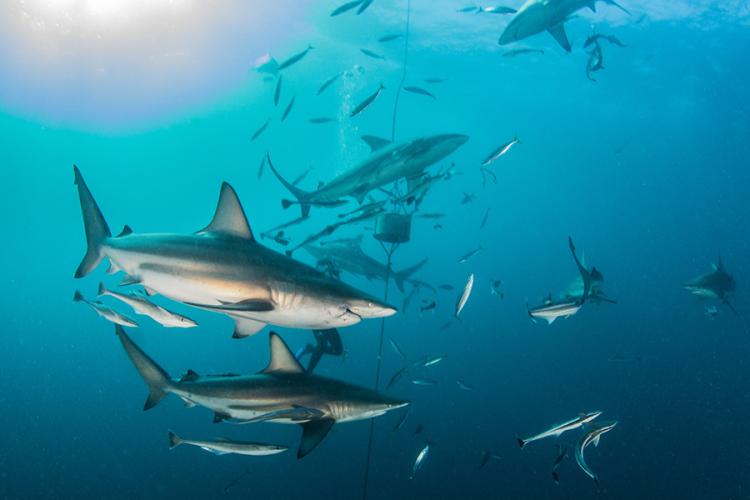How Big Does a Black Tip Reef Shark Get
Atlantic Blacktip Shark

About the Species
U.S. wild-caught Atlantic blacktip shark is a smart seafood choice because it is sustainably managed and responsibly harvested under U.S. regulations.

Population
Above target population levels in the Gulf of Mexico and the Atlantic.

Fishing Rate
At recommended levels.

Habitat Impacts
Gear used to catch blacktip sharks has minimal impact on habitat.

Bycatch
Regulations are in place to minimize bycatch.
Population Status
- There are two stocks of blacktip shark: Gulf of Mexico and Atlantic. According to the most recent stock assessments:
- The Gulf of Mexico stock is not overfished and not subject to overfishing (2018 stock assessment). Summary stock assessment information can be found on Stock SMART.
- The Atlantic stock is not overfished and not subject to overfishing (2021 stock assessment). Summary stock assessment information can be found on Stock SMART.
Appearance
- Atlantic blacktip sharks are gray to gray-brown, with white on the belly and a conspicuous wedge-shaped band or Z-shaped line on the sides.
- Their pectoral, dorsal, and tail fins have black tips, but the anal fin is white.
- Their bodies have a torpedo shape, which allows them to swim through the water with little effort.
- Atlantic blacktip sharks are often confused with spinner sharks due to their similar size, shape, coloration, and behavior. Both species are known for leaping and spinning out of the water while feeding on schools of fish. A distinguishing feature is that the anal fin on the blacktip shark is white whereas the anal fin of the spinner shark has a black tip.
Biology
- Atlantic blacktip sharks grow quickly, and can reach up to 6 feet in length. The oldest observed blacktip shark was 15.5 years old.
- They often form large groups, segregated into separate schools of males and females when they are not mating. They mate between March and June.
- Males mature at 4 to 5 years of age, while females mature later, at 6 to 7 years of age.
- Females have an 11- to 12-month gestation period and give birth to an average of three pups per litter in the Atlantic and four to five pups per litter in the Gulf of Mexico.
- Pups are born in shallow nursery grounds away from the adult population. After giving birth, the females leave the nursery area while juveniles remain.
- Blacktip sharks eat bony fishes, smaller sharks, squids, stingrays, shrimp, and crabs. They often follow fishing boats and are sometimes seen consuming discarded fish.
Where They Live
- Atlantic blacktip sharks can be found year-round in the Gulf of Mexico and are common from Virginia through Florida.
- They have been known to migrate as far north as Cape Cod, Massachusetts.
Fishery Management
- NOAA Fisheries and the Atlantic Highly Migratory Species Division manage the Atlantic blacktip shark fishery.
- Managed under the Consolidated Highly Migratory Species Fishery Management Plan:
- Permits are required, and only a limited number of permits are available.
- Commercial quotas and limits on how many sharks can be landed per fishing trip.
- Gear restrictions and requirements.
- Fishing season is generally year-round, but individual commercial shark fisheries close when the quota is reached.
- Shark dealers are required to attend Atlantic shark identification workshops to help them better identify shark species.
- Prohibited species—there are more than 20 species of sharks that cannot be landed (e.g., white, dusky, basking, longfin mako, night). Some of these species look similar to the species that can be landed. The recreational shark identification and the prohibited shark identification placards can help with identification.
- The Shark Conservation Act requires that all sharks, with one exception, be brought to shore with their fins naturally attached.
- Compliance guides are available for all commercial and recreational regulations across Atlantic highly migratory species fisheries.
- Unlike some highly migratory shark species, there is no international management for Atlantic blacktip sharks at this time.
Harvest
- In 2019, commercial landings of Atlantic and Gulf of Mexico blacktip sharks totaled 211,200 pounds, and were valued at $121,700, according to the NOAA Fisheries commercial fishing landings database.
- To commercially harvest Atlantic sharks, vessel owners must obtain a valid Atlantic shark directed or incidental limited access permit or a smoothhound shark open access permit. More information regarding limited access permits can be found in the Atlantic HMS commercial compliance guide.
- Atlantic blacktip sharks belong to the large coastal shark complex.
- Gear types, habitat impacts, and bycatch:
- Bottom longlines and gillnets are used to catch Atlantic blacktip sharks.
- Gear used to catch blacktip sharks may catch other species, including marine mammals and turtles.
- Fishermen using bottom longline or gillnet gear must complete a protected species safe handling, release, and identification workshop.
- Certain areas are closed to shark fishing to protect nursery areas, sensitive habitats, and populations.
- Vessel monitoring systems ensure fishermen are complying with area closures.
- To reduce bycatch of fish, including Atlantic blacktip sharks, shrimp trawlers are required to use bycatch reduction devices, which are designed to retain shrimp but allow fish to exit the net.
- Recreational fishermen typically use rod-and-reel gear for blacktip sharks:
- In 2019, recreational anglers landed more than 74,000 pounds of blacktip shark, according to the NOAA Fisheries recreational fishing landings database.
- Recreational fishermen must have an Atlantic HMS permit to harvest Atlantic blacktip sharks in federal waters. As of January 1, 2018, all HMS recreational permit holders will need a "shark endorsement" to fish for, retain, possess, or land sharks.
- Fishermen fishing recreationally for sharks will be required to use circle hook in most places. For more information regarding these requirements, please refer to HMS regulations and the Amendment 5b compliance guide.
- Blacktip sharks are a popular recreational species because they are found near shore and often jump and spin out of the water.
Featured News
 Small tiger shark captured for tagging and release 2021 Coastal Shark Survey. Credit: NOAA Fisheries/Apex Predator Program.
Small tiger shark captured for tagging and release 2021 Coastal Shark Survey. Credit: NOAA Fisheries/Apex Predator Program.

 Pelagic blacktip shark in open water. Credit: Madelein_Wolf/Getty Images
Pelagic blacktip shark in open water. Credit: Madelein_Wolf/Getty Images
Recreational Fishing Regulations
Commercial Fishing Regulations
Subsistence Fishing Regulations
Science Overview
NOAA Fisheries conducts shark research in the Northeast, studying shark life history and performing long-term monitoring activities essential for stock assessment and management.
Data & Maps
How Big Does a Black Tip Reef Shark Get
Source: https://www.fisheries.noaa.gov/species/atlantic-blacktip-shark